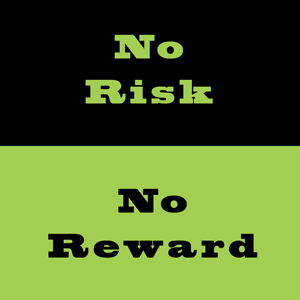 Business walks a fine line between taking risks and getting the reward for the effort. Let me explain.
Business walks a fine line between taking risks and getting the reward for the effort. Let me explain.
Risks are Necessary
Research and development folks are encouraged to take risks, think outside of the box, etc. to find that next breakthrough, that next fabulous product.
Artists and creatives are encouraged to do the same thing to create the best performance, artwork, etc. (plug for my hero, Lin-Manuel Miranda of Hamilton fame!!).
Risks are what lets these ideas bloom. If we clamped down on these people taking risks, we’d still have outdoor plumbing. Ugh!
What about the rest of us?
I can only speak from my own experience.
For the run of the mill worker, taking risks is a bad, or at least questionable, practice. You have a budget, or a deadline, or both so taking risks can put both in jeopardy. And that is a bad, bad thing that can have direct paycheck results. That kind of ‘reward’ really reduces the incentive for taking risks. This results in project looking the same a lot of times. Sometimes that’s okay and sometimes not.
Risk and eLearning
Here’s where it gets tricky.
Effective eLearning has to engage the user. We all agree on that (or I think so?). The HOW is the issue.
Gamification is a big thing and very engaging. People LOVE accumulating points or widgets or whatever. It’s a point of pride really, a competition.
Creating courses with gamification can be a big risk. It’s a whole different way of thinking about courses and designing curriculum.
Risks and Deadlines
Balance the risk with deadlines. The Marketing department needs a course on the new sales stuff NOW, not 10 weeks from now. Yea, sure, games and things are cute, but just get it done, would ya?
There is such a push to get training done for so many things that the workload is overwhelming. A lot of shops just use templates, slap words into it to teach the content, and move on to the next project. They don’t want to take the time to even put audio to the courses.
Is it effective? Yes, in a way. The information is getting out to the people in a timely manner. Is it memorable? Probably not. Using more channels (audio, visual, physical) tends to make the learning stick better. Would the information in a gamified course stick more? Probably.
Conclusion
It’s all about balance.
We need to move to more effective formats for elearning yet keep up with our fast paced world by getting the training out in time for it to still be useful.
There’s no easy answer.
Educating those that request training materials may be one of the best avenues for the future. Start planting ideas about alternative, more interactive, more interesting ways to learn. Maybe dig up some statistics verifying what you say.
And don’t expect immediate results. We’re growing an oak tree here, not a weed.


